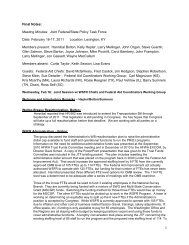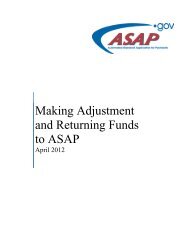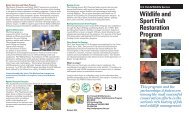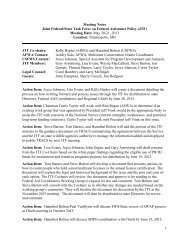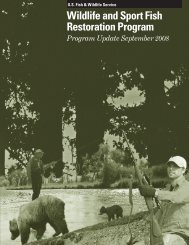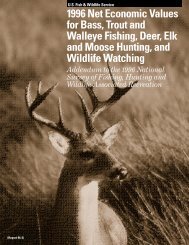Financial Returns To Industry From The Federal Aid - Wildlife and ...
Financial Returns To Industry From The Federal Aid - Wildlife and ...
Financial Returns To Industry From The Federal Aid - Wildlife and ...
Create successful ePaper yourself
Turn your PDF publications into a flip-book with our unique Google optimized e-Paper software.
presented here were h<strong>and</strong> selected <strong>and</strong> do not represent a r<strong>and</strong>om sampling of all<br />
<strong>Wildlife</strong> Restoration projects.<br />
Case studies presented here were identified using a two pronged approach <strong>The</strong> first<br />
round occurred in early 2009 when state fish-<strong>and</strong>-wildlife departments nationwide were<br />
asked to identify projects that met budget <strong>and</strong> hunter participation data requirements.<br />
Approximately 11 projects receiving <strong>Wildlife</strong> Restoration funds were received. Followup<br />
contact was made with each project manager to discuss the project as well as<br />
investigate the availability of required data. While a number of projects initially<br />
nominated are included as case studies, the breadth of projects identified was not<br />
viewed to be fully representative of the variety of projects across the nation receiving<br />
<strong>Wildlife</strong> Restoration funds. Some project types by themselves do not lend themselves to<br />
a quantitative ROI analysis (e.g., wildlife health research, education centers) even<br />
though they ultimately contribute to continued participation in hunting <strong>and</strong> shooting<br />
sports. In other cases, investments have not been made to collect the necessary data<br />
(e.g., participation before <strong>and</strong> after the project) or the accounting mechanisms in place<br />
at the state level are not suited for breaking out the investment data as needed for an<br />
ROI analysis.<br />
<strong>The</strong> second approach involved a review of U.S. Fish <strong>and</strong> <strong>Wildlife</strong> Service‟s <strong>Federal</strong> <strong>Aid</strong><br />
Information Management System (FAIMS) database. <strong>The</strong> goal was to select projects<br />
for follow-up that would, as a whole, reflect a broad cross-section of projects based<br />
upon project type <strong>and</strong> location. Project managers were contacted to discuss the project<br />
as well as investigate the availability of required data.<br />
None of the cases presented should be seen as an affirmation of any one particular<br />
project over another. All projects were explored in depth to determine the level of data<br />
available to analyze a return on investment. Those studies presented here are those<br />
that offered a rich level of data, as well as representing a diverse array of funded<br />
projects.<br />
History <strong>and</strong> Evolution of the <strong>Wildlife</strong> Restoration Program<br />
While the <strong>Federal</strong> <strong>Aid</strong> in <strong>Wildlife</strong> Restoration program [commonly known as the Pittman-<br />
Robertson Act (or PR) in honor of its two prime sponsors, Senators Key Pittman (NV)<br />
<strong>and</strong> A. Willis Robertson (VA)], was passed into law in 1937, its roots go back more than<br />
a decade prior to its passage. In 1919, John B. Burnham, president of the American<br />
Game Association (the predecessor of the <strong>Wildlife</strong> Management Institute) wrote, "If the<br />
young men of the next generation are to enjoy from the country's wild life anything like<br />
the benefits derived by present outdoor man, we must be the ones that shoulder the<br />
9




